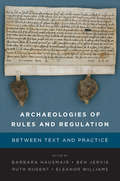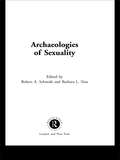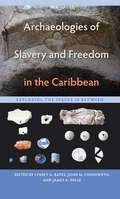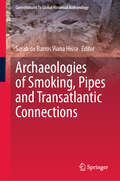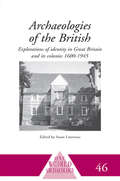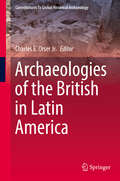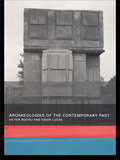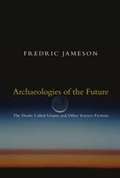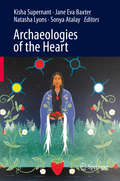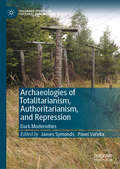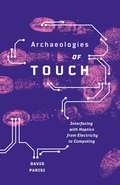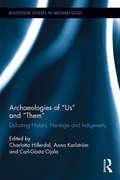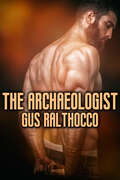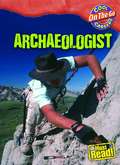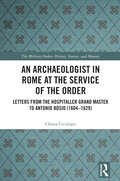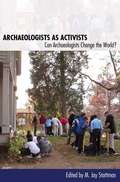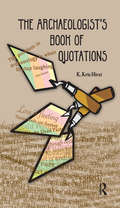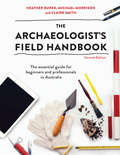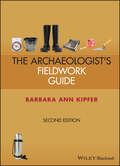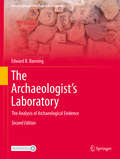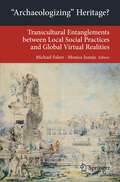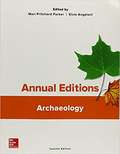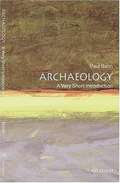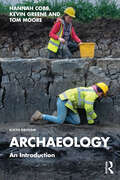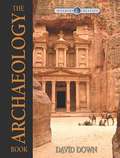- Table View
- List View
Archaeologies of Rules and Regulation: Between Text and Practice
by Barbara Hausmair Ben Jervis Ruth Nugent Eleanor WilliamsHow can we study the impact of rules on the lives of past people using archaeological evidence? To answer this question, Archaeologies of Rules and Regulation presents case studies drawn from across Europe and the United States. Covering areas as diverse as the use of space in a nineteenth-century U.S. Army camp, the deposition of waste in medieval towns, the experiences of Swedish migrants to North America, the relationship between people and animals in Anglo-Saxon England, these case studies explore the use of archaeological evidence in understanding the relationship between rules, lived experience, and social identity.
Archaeologies of Sexuality: Race And Sexuality In Colonial San Francisco
by Robert A. Schmidt Barbara L. VossStatus, age and gender have long been accepted aspects of archaeological enquiry, yet it is only recently that archaeologists have started seriously to consider the role of sex and sexuality in their studies.Archaeologies of Sexuality is a timely and pioneering work. It presents a strong, diverse body of scholarship which draws on locations as varied as medieval England, the ancient Maya kingdoms, New Kingdom Egypt, prehistoric Europe, and convict-era Australia, demonstrating the challenges and rewards of integrating the study of sex and sexuality within archaeology.This volume, with contributions by many leading archaeologists, will serve both as an essential introduction and a valuable reference tool for students and academics.
Archaeologies of Slavery and Freedom in the Caribbean: Exploring the Spaces in Between ( Florida Museum of Natural History: Ripley P. Bullen Series)
by Lynsey A. Bates John M. Chenoweth James A. DelleCaribbean plantations and the forces that shaped them--slavery, sugar, capitalism, and the tropical, sometimes deadly environment--have been studied extensively. This volume brings together alternate stories of sites that fall outside the large cash-crop estates. Employing innovative research tools and integrating data from Dominica, St. Lucia, the Dominican Republic, Jamaica, Barbados, Nevis, Montserrat, and the British Virgin Islands, the contributors investigate the oft-overlooked interstitial spaces where enslaved Africans sought to maintain their own identities inside and outside the fixed borders of colonialism. Despite grueling work regimes and social and economic restrictions, people held in bondage carved out places of their own at the margins of slavery's reach. These essays reveal a complex world within and between sprawling plantations--a world of caves, gullies, provision grounds, field houses, fields, and the areas beyond them, where the enslaved networked, interacted, and exchanged goods and information. The volume also explores the lives of poor whites, Afro-descendant members of military garrisons, and free people of color, demonstrating that binary models of black slaves and white planters do not fully encompass the diversity of Caribbean identities before and after emancipation. Together, the analyses of marginal spaces and postemancipation communities provide a more nuanced understanding of the experiences of those who lived in the historic Caribbean, and who created, nurtured, and ultimately cut the roots of empire. A volume in the Florida Museum of Natural History: Ripley P. Bullen Series
Archaeologies of Smoking, Pipes and Transatlantic Connections (Contributions To Global Historical Archaeology)
by Sarah de Barros Viana HissaThis volume presents a global study of the economic and cultural global systems in which smoking materials, practices and ideas circulate, intertwine, and transform. This book compiles original work authored by researchers from the Americas, Africa, and Europe to elicit a comparative archaeology of smoking and pipes through histories and case studies from localities and regions on both sides of the Atlantic. Consequently, the book is divided into four sections divided by region. The first chapters focus on Amerindian pipes and smoking, and these are followed by research on smoking and clay pipe use in post-17th century Europe. Chapters on the production and use of clay smoking pipes in Brazil and a reflection on the influence of pipes and smoking in Senegambia comprise the final two sections respectively. Taken together, this volume explores a wide range of issues, such as economic and cultural relations between old and new worlds; the effects of colonization in different parts of the globe; circulation of ideas, practices, and objects in hegemonic and non-hegemonic transatlantic connections; techniques and styles of making and decorating pipes; materialization and expression of ethnicities and of their blurred frontiers; changes and continuities observed in smoking materials and their inferred meanings. The book compiles fresh insights on the complex and diverse history of smoking and transatlantic economic and cultural interactions associated with it. It is of interest to both historical and pre-historical archaeologists researching material culture in several regions of the world, but also historians and anthropologists interested in material culture and global cultural systems.
Archaeologies of the British: Explorations of Identity in the United Kingdom and Its Colonies 1600-1945
by Susan LawrenceBeginning with the early English colonisation of Ireland and Virginia, the international range of contributors in Archaeology of the British examine the interplay of objects and identity in Scotland and Wales, regional England, Canada, Australia, South Africa, Cyprus, and Sri Lanka. Informed by developments in historical archaeology and by postcolo
Archaeologies of the British in Latin America (Contributions To Global Historical Archaeology)
by Charles E. Orser Jr.This volume includes chapters by historical archaeologists engaged in original research examining the role of the British Empire in Latin America. The archaeology of Latin America is today a rapidly expanding field, with new research being accomplished every day. Currently, the vast amount of research is being focused on the Spanish Empire and its agents’ interactions with the region’s indigenous peoples. Spain, however, was not the only international power intent on colonizing and controlling Latin America. The British Empire had a smaller albeit significant role in the cultural history of Latin America. This history constitutes an important piece of the historical story of Latin America. Archaeologies of the British in Latin America presents the results of original research and begins a dialogue about the archaeology of the British Empire in Latin America by an international group of archaeological scholars. Fresh insights on the complex history of cultural interaction in one of the world’s most important regions are included. It will be of interest to historical archaeologists, Mesoamerican archaeologists engaged in pre-contact research, Latin American and global historians, Latin American anthropologists, material culture specialists, cultural geographers, and others interested in the cultural history of colonialism in general and in Latin America in particular.
Archaeologies of the Contemporary Past
by Victor Buchli Gavin LucasArchaeologies of the Contemporary Past turns what is usually seen as a method for investigating the distant past onto the present. In doing so, it reveals fresh ways of looking both at ourselves and modern society as well as the discipline of archaeology.This volume represents the most recent research in this area and examines a variety of contexts including:* Art Deco* landfills* miner strikes* college fraternities* an abandoned council house.
Archaeologies of the Future: The Desire Called Utopia and Other Science Fictions
by Fredric JamesonIn an age of globalization characterized by the dizzying technologies of the First World, and the social disintegration of the Third, is the concept of utopia still meaningful? <P><P>Archaeologies of the Future, Jameson's most substantial work since Postmodernism, Or, the Cultural Logic of Late Capitalism, investigates the development of this form since Thomas More, and interrogates the functions of utopian thinking in a post-Communist age. The relationship between utopia and science fiction is explored through the representations of otherness ... alien life and alien worlds ... and a study of the works of Philip K. Dick, Ursula LeGuin, William Gibson, Brian Aldiss, Kim Stanley Robinson and more. Jameson's essential essays, including "The Desire Called Utopia," conclude with an examination of the opposing positions on utopia and an assessment of its political value today.
Archaeologies of the Heart
by Sonya Atalay Kisha Supernant Jane Eva Baxter Natasha LyonsArchaeological practice is currently shifting in response to feminist, indigenous, activist, community-based, and anarchic critiques of how archaeology is practiced and how science is used to interpret the past lives of people. Inspired by the calls for a different way of doing archaeology, this volume presents a case here for a heart-centered archaeological practice. Heart-centered practice emerged in care-based disciplines, such as nursing and various forms of therapy, as a way to recognize the importance of caring for those on whom we work, and as an avenue to explore how our interactions with others impacts our own emotions and heart. Archaeologists are disciplined to separate mind and heart, a division which harkens back to the origins of western thought. The dualism between the mental and the physical is fundamental to the concept that humans can objectively study the world without being immersed in it. Scientific approaches to understanding the world assume there is an objective world to be studied and that humans must remove themselves from that world in order to find the truth. An archaeology of the heart rejects this dualism; rather, we see mind, body, heart, and spirit as inextricable. An archaeology of the heart provides a new space for thinking through an integrated, responsible, and grounded archaeology, where there is care for the living and the dead, acknowledges the need to build responsible relationships with communities, and with the archaeological record, and emphasize the role of rigor in how work and research is conducted. The contributions bring together archaeological practitioners from across the globe in different contexts to explore how heart-centered practice can impact archaeological theory, methodology, and research throughout the discipline.
Archaeologies of Totalitarianism, Authoritarianism, and Repression: Dark Modernities (Palgrave Studies in Cultural Heritage and Conflict)
by James Symonds Pavel VařekaThis book offers new insights into the mechanisms of state control, systematic repression and mass violence focused on ethnic, political, class, and religious minorities in the recent past. The geographical and temporal scope of the volume breaks new ground as international scholars foreground how contemporary archaeology can be used to enhance the documentation and interpretation of totalitarian and authoritarian regimes, to advance theoretical approaches to atrocities, and to broaden public understandings of how such regimes use violence and repression to hold on to power.
Archaeologies of Touch: Interfacing with Haptics from Electricity to Computing
by David ParisiA material history of haptics technology that raises new questions about the relationship between touch and media Since the rise of radio and television, we have lived in an era defined increasingly by the electronic circulation of images and sounds. But the flood of new computing technologies known as haptic interfaces—which use electricity, vibration, and force feedback to stimulate the sense of touch—offering an alternative way of mediating and experiencing reality. In Archaeologies of Touch, David Parisi offers the first full history of these increasingly vital technologies, showing how the efforts of scientists and engineers over the past three hundred years have gradually remade and redefined our sense of touch. Through lively analyses of electrical machines, videogames, sex toys, sensory substitution systems, robotics, and human–computer interfaces, Parisi shows how the materiality of touch technologies has been shaped by attempts to transform humans into more efficient processors of information. With haptics becoming ever more central to emerging virtual-reality platforms (immersive bodysuits loaded with touch-stimulating actuators), wearable computers (haptic messaging systems like the Apple Watch&’s Taptic Engine), and smartphones (vibrations that emulate the feel of buttons and onscreen objects), Archaeologies of Touch offers a timely and provocative engagement with the long history of touch technology that helps us confront and question the power relations underpinning the project of giving touch its own set of technical media.
Archaeologies of Us and Them: Debating History, Heritage and Indigeneity (Routledge Studies in Archaeology)
by Charlotta Hillerdal Anna Karlström Carl-Gösta OjalaArchaeologies of “Us” and “Them” explores the concept of indigeneity within the field of archaeology and heritage and in particular examines the shifts in power that occur when ‘we’ define ‘the other’ by categorizing ‘them’ as indigenous. Recognizing the complex and shifting distinctions between indigenous and non-indigenous pasts and presents, this volume gives a nuanced analysis of the underlying definitions, concepts and ethics associated with this field in order to explore Indigenous archaeology as a theoretical, ethical and political concept. Indigenous archaeology is an increasingly important topic discussed worldwide, and as such critical analyses must be applied to debates which are often surrounded by political correctness and consensus views. Drawing on an international range of global case studies, this timely and sensitive collection significantly contributes to the development of archaeological critical theory.
The Archaeologist
by Gus RalthoccoLeopold is an archaeologist working in Malta over the summer alongside students from a visiting university, and Anton, the translator who came to help out. At the start, Anton shares his desire for Leopold. They promise to keep in touch, but Leopold loses his phone, and Anton spirals from low self-esteem.They reunite through Leopold’s brother, who manages to track down Anton after he realizes Leopold had someone on his mind. When the two meet again, they realize the moment they had together was incredible for both of them and the spark is still alive, but if they want to have a relationship, they need more than that.Do Leopold and Anton have what it takes to stay together?
Archaeologist (Cool on the Go Careers)
by William David ThomasWhat do bone fragments, pieces of cracked pottery, and crystal skulls have in common? Archaeologists have found them all! Discover how archaeologists research where to dig, what to look for, and how to date and catalog the artifacts they find. Dig up the secrets of archaeology and learn the skills needed to succeed in this amazing field.
An Archaeologist in Rome at the Service of the Order: Letters from the Hospitaller Grand Master to Antonio Bosio (1604–1629) (The Military Religious Orders)
by Chiara CecalupoAn Archaeologist in Rome at the Service of the Order presents the so-far completely unknown letters between the Grand Masters (Alof de Wignacourt, Luís Mendes de Vasconcellos and Antoine de Paule) and Antonio Bosio, who is well known worldwide for his extensive discoveries of the Roman Christian catacombs and was also an Agent of the Order of Malta in Rome. The letters were sent between 1604 and 1629 and are currently held at the National Library of Malta.After a complete account on Bosio’s biography and family history, the letters are transcribed, translated and commented, in order to open a window on the role of the Agent in Rome in the very early seventeenth century, a particular juncture in the Order’s history, and on the relations between Malta and Rome.The study and publication of these materials make it possible to present Antonio Bosio’s political and administrative works at the service of the Grand Master to the international public and academics interested in the history of the Order.
Archaeologists As Activists: Can Archaeologists Change The World?
by M. Stottman Stephen McBride Carol McDavid Sarah Miller Matthew Prybylski Lois Stahlgren Jodi Barnes Robert Chidester Kim Christensen David Gadsby A. Henderson Patrice Jeppson Barbara Little Kim McBrideCould archaeologists benefit contemporary cultures and be a factor in solving world problems? Can archaeologists help individuals? Can archaeologists change the world? These questions form the root of “archaeology activism” or “activist archaeology”: using archaeology to advocate for and affect change in contemporary communities. <p><p> Archaeologists currently change the world through the products of their archaeological research that contribute to our collective historical and cultural knowledge. Their work helps to shape and reshape our perceptions of the past and our understanding of written history. Archaeologists affect contemporary communities through the consequences of their work as they become embroiled in controversies over negotiating the past and the present with native peoples. Beyond the obvious economic contributions to local communities caused by heritage tourism established on the research of archaeologists at cultural sites, archaeologists have begun to use the process of their work as a means to benefit the public and even advocate for communities. <p> In this volume, Stottman and his colleagues examine the various ways in which archaeologists can and do use their research to forge a partnership with the past and guide the ongoing dialogue between the archaeological record and the various contemporary stakeholders. They draw inspiration and guidance from applied anthropology, social history, public history, heritage studies, museum studies, historic preservation, philosophy, and education to develop an activist approach to archaeology—theoretically, methodologically, and ethically.
The Archaeologist's Book of Quotations
by K Kris Hirst“Hell, I don't break the soil periodically to 'reaffirm my status'. I do it because archeology is still the most fun you can have with your pants on.” - Kent V. Flannery. In her quest to make archaeology available to the public, Kris Hirst has put together a collection of over 400 pithy quotes from archaeologists and others about the science of archaeology or the mysteries of history and the past. The quotations are categorized into subject areas with full citations and context and include sections on fieldwork, the uses of archaeology, ethics, ownership of the past, lessons of archaeology, and many other topics. Hirst’s book is a great resource for students, academics and others browsing for suitable quotes for use in classroom presentations, student papers, and research articles.
The Archaeologist's Field Handbook: The essential guide for beginners and professionals in Australia
by Claire Smith Heather Burke Michael MorrisonIn one volume here is everything you need to conduct fieldwork in archaeology. The Archaeologist's Field Handbook is designed for every kind of archaeological practice, from simple site recordings to professional consultancies and anyone who wants to record heritage sites responsibly.This hands-on manual provides step-by-step instructions on how to undertake and successfully complete fieldwork in all fields of archaeology, from Indigenous to historical to landscape work. Charts, checklists, graphs, maps and diagrams clearly illustrate how to design, fund, research, map, record, interpret, photograph and write up your fieldwork.This second edition is updated throughout and incorporates strategies for digital data capture, improved methods, recent legislation and more affordable technologies for surveying and photography. The Archaeologist's Field Handbook remains the ultimate resource for consultants, teachers, students, community groups and anyone involved in heritage fieldwork.'An essential aid for beginners and professionals.' - Emeritus Professor John Mulvaney'This volume has become the standard for archaeological field training ... A must for students, professionals and community groups.' - Martin Gibbs, Professor of Archaeology, University of New England'It is absolutely the 'go to' field manual for archaeologists whatever their level within the profession.' - Jane Balme, Associate Professor of Archaeology, University of Western Australia
Archaeologist's Fieldwork Guide
by Barbara Ann KipferThe new edition of the most comprehensive, practical, and user-friendly guide of its kind, providing quick reference to the information needed by archaeologists doing fieldwork The Archaeologist's Fieldwork Guide is the must-have companion for anyone planning and performing fieldwork, whether a student going into the field for the first time or a professional archaeologist with years of real-world experience. Designed to be an all-in-one informational toolkit, the Guide is packed with the technical and practical information archaeologists need to know when in the field—supported by more than 400 lists and checklists, planning aids, measurement charts and tables, analysis and classification guides, sample forms, abbreviations and codes, and much more. Fully revised throughout, the second edition features two entirely new chapters on technology in the field and the archaeology laboratory, incorporating current tools and technologies such as geographic information systems (GIS), 3D data capture and modeling, DNA extraction, light detection and ranging (LiDAR) scanning, remotely controlled drones, and underground mapping. New and updated coverage includes flotation samples and processing, oxidizable carbon ratio dating, phytolith sampling, and water screening. Covers classification and typology, creating forms and records, measurement and conversion, laboratory handling and processing, artifact mapping, drawing, and photographing Offers new and updated material on legislation regarding archaeological fieldwork and emerging topics such as community engagement and public archaeology. Provides up-to-date definitions and explanations of key terms and new diagrams, line drawings, and glosses Includes a guide to research publication, an extensive bibliography, references to relevant associations and publications, and information on where to buy suppliesThe Archaeologist’s Fieldwork Guide, Second Edition is an indispensable resource for undergraduate and graduate archaeology students, students taking courses in anthropology, ethnography, and cultural resource management (CRM), archaeology enthusiasts and volunteers, and professional archeologists at any level.
The Archaeologist's Laboratory: The Analysis of Archaeological Evidence (Interdisciplinary Contributions to Archaeology)
by Edward B. BanningThis second edition of the classic textbook, The Archaeologist’s Laboratory, is a substantially revised work that offers updated information on the archaeological work that follows fieldwork, such as the processing and analysis of artifacts and other evidence. An overarching theme of this edition is the quality and validity of archaeological arguments and the data we use to support them. The book introduces many of the laboratory activities that archaeologists carry out and the ways we can present research results, including graphs and artifact illustrations. Part I introduces general topics concerning measurement error, data quality, research design, typology, probability and databases. It also includes data presentation, basic artifact conservation, and laboratory safety. Part II offers brief surveys of the analysis of lithics and ground stone, pottery, metal artifacts, bone and shell artifacts, animal and plant remains, and sediments, as well as dating by stratigraphy, seriation and chronometric methods. It concludes with a chapter on archaeological illustration and publication. A new feature of the book is illustration of concepts through case studies from around the world and from the Palaeolithic to historical archaeology.The text is appropriate for senior undergraduate students and will also serve as a useful reference for graduate students and professional archaeologists.
'Archaeologizing' Heritage?: Transcultural Entanglements between Local Social Practices and Global Virtual Realities (Transcultural Research – Heidelberg Studies on Asia and Europe in a Global Context)
by Michael Falser Monica JunejaThis book investigates what has constituted notions of "archaeological heritage" from colonial times to the present. It includes case studies of sites in South and Southeast Asia with a special focus on Angkor, Cambodia. The contributions, the subjects of which range from architectural and intellectual history to historic preservation and restoration, evaluate historical processes spanning two centuries which saw the imagination and production of "dead archaeological ruins" by often overlooking living local, social, and ritual forms of usage on site. Case studies from computational modelling in archaeology discuss a comparable paradigmatic change from a mere simulation of supposedly dead archaeological building material to an increasing appreciation and scientific incorporation of the knowledge of local stakeholders. This book seeks to bring these different approaches from the humanities and engineering sciences into a trans-disciplinary discussion.
Archaeology
by Elvio Angeloni Mari Pritchard ParkerAnnual Editions: Archaeology has been compiled by its two editors with the intent of presenting a vivid overview of the field of archaeology as practiced today. It is our hope that these readings, in keeping with its previous editions will make the old bones, shards of pottery, and stone tools of the past pop into the present.
Archaeology: A Very Short Introduction
by Paul BahnThis little book is merely intended to whet the appetite by presenting some rudiments of the subject of archaeology in the hope that the reader may be stimulated to delve more deeply into its rich literature, to carry out some research or fieldwork, or, in the case of students, decide to take it up as a university course. You may not find employment at the end of such a course, or even at the end of a Ph.D.; but in these days when even the 'safe' areas like banking no longer guarantee a job for life, you might as well enjoy yourself while you can, and - as the late Glyn Daniel often emphasized - archaeology is nothing if it is not about pleasure. Inevitably you may need to shift and sieve a lot of earth, memorize some boring dates, wrap your tongue round meaningless jargon, and try to grapple with the Sumo wrestlers of theory, but at the same time you will be transported into a world of art and artefacts, temples and tools, tombs and treasures, lost cities and mysterious scripts, mummies and mammoths.
Archaeology: An Introduction
by Hannah Cobb Kevin Greene Tom MooreThis fully updated sixth edition of a classic classroom text is essential reading for core courses in archaeology.Archaeology: An Introduction explains how the subject emerged from an amateur pursuit in the eighteenth century into a serious discipline and explores changing trends in interpretation in recent decades. The authors convey the excitement of archaeology while helping readers to evaluate new discoveries by explaining the methods and theories that lie behind them. In addition to drawing upon examples and case studies from many regions of the world and periods of the past, the book incorporates the authors’ own fieldwork, research and teaching. It continues to include key reference and further reading sections to help new readers find their way through the ever-expanding range of archaeological publications and online sources as well as colour illustrations and boxed topic sections to increase comprehension.Serving as an accessible and lucid textbook, and engaging students with contemporary issues, this book is designed to support students studying Archaeology at an introductory level.New to the sixth edition: Inclusion of the latest survey and imaging techniques, such as the use of drones and eXtended reality. Updated material on developments in dating, DNA analysis, isotopes and population movement, including consideration of the ethical considerations of these techniques. Coverage of new developments in archaeological theory, such as the material turn/ontological turn, and work on issues of equality, diversity and inclusion. A whole new chapter covering archaeology in the present, including new sections on heritage and public archaeology, and an updated consideration of archaeology’s relationship with the climate crisis. A revised glossary with over 200 new additions or updates.
The Archaeology
by David DownDeveloped with three educational levels in mind, The Archaeology Book takes you on an exciting exploration of history and ancient cultures. You'll learn both the techniques of the archaeologist and the accounts of some of the richest discoveries of the Middle East that demonstrate the accuracy and historicity of the Bible.
